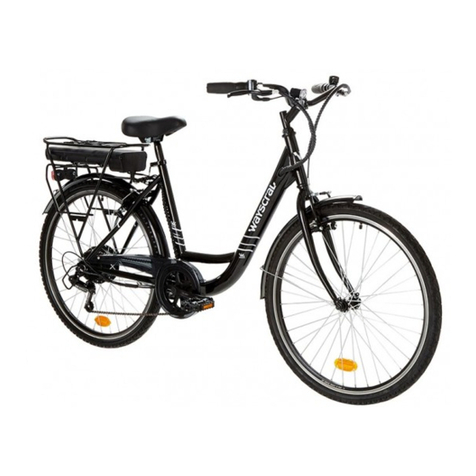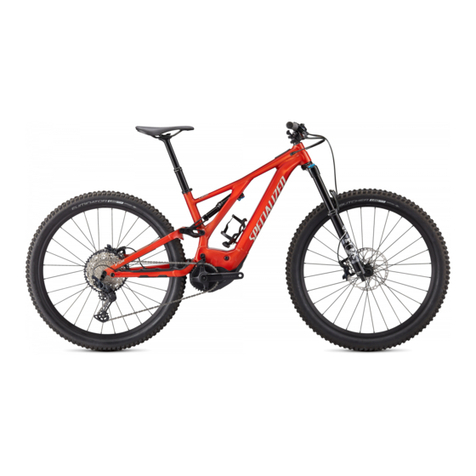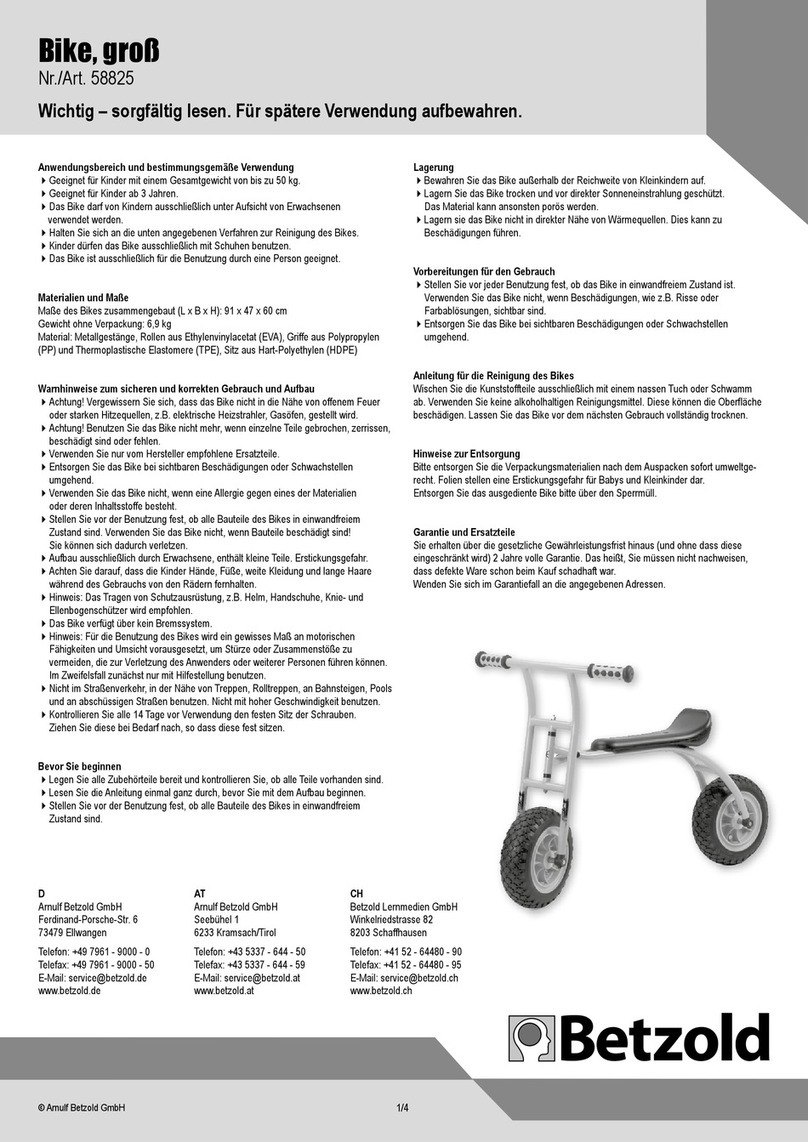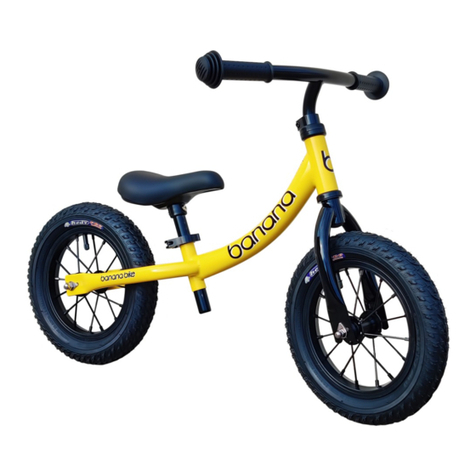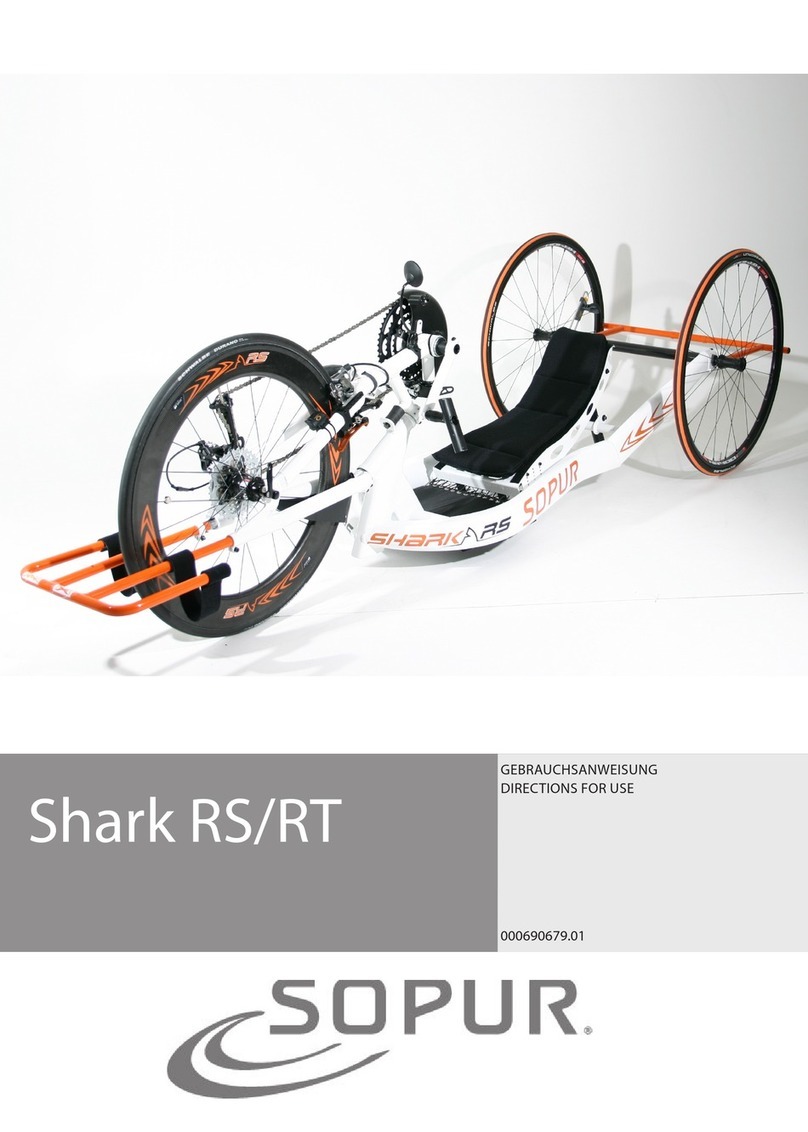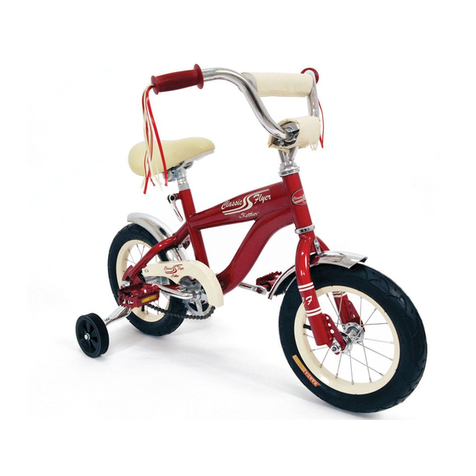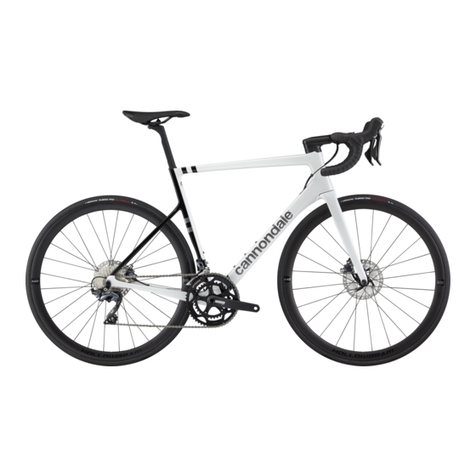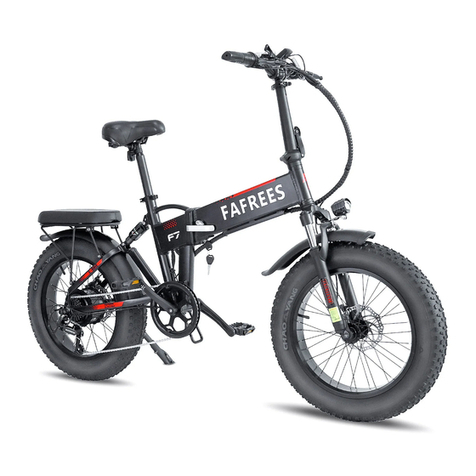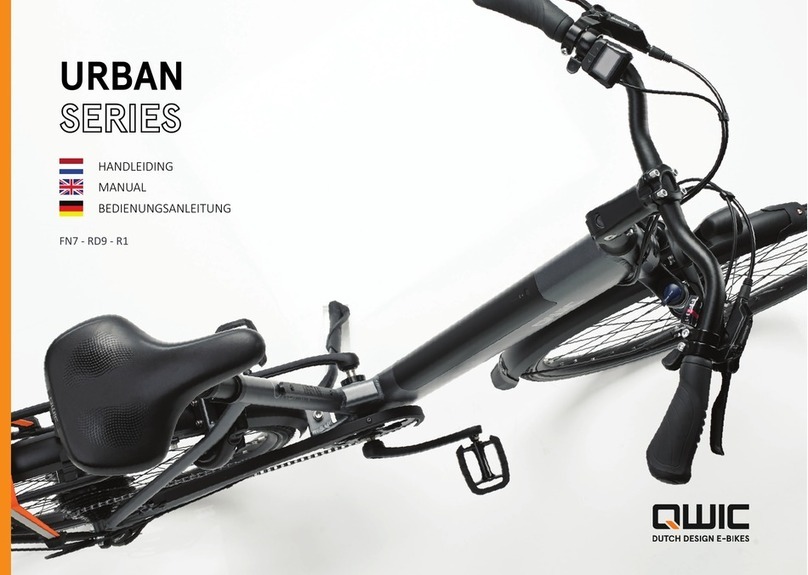BLUEREV MOTO81 User manual

U S E R M A N U A L

2
U S E R M A N U A L
CONTENTS
Welcome P a g e 3
Bike Parts Diagram Page 4
Safety Check P a g e 5
Using the Bike P a g e 6
Maintenance P a g e 6
Assembly P a g e 7
Battery Charging P a g e 9
Rear Suspension Page 10
SW900 COMPUTER DISPLAY Page 11
Cleaning and Tips Page 12
Legal Requirement Page 12
Serial Number Page 13
Warranty Page 13
Help Centre Page 14

3
U S E R M A N U A L
Congratulations on purchasing your new Bluerev Bike!
You have chosen wisely!
Your Bluerev bike will give you a superb riding experience for
many years to come.
Please read this manual carefully before using your bike it will
help you assemble your bike properly and keep your bike in
top condition, more importantly this will ensure your safety
while using the bike.
If you don’t feel comfortable assembling the bike on your own
it is highly recommended that you have your bike assembled
by a bicycle mechanic.
If you have any other questions please refer to the
BLUEREV website’s contact page to speak to us.
www.bluerev.ca
Email: [email protected]
Phone: 1-647-715-9000
THANK YOU FOR CHOOSING BLUEREV!

FRAME
SADDLE
RACK
REAR
LIGHT
CONTROLLER
SUSPENSION
SHOCKS
MOTOR
CRANKS
CHAIN
PEDAL
REAR
WHEEL
DERAILLEUR
BATTERY
HANDLEBAR
LED
FRONT
LIGHT
FENDER
FRONT
BRAKE
RIM
TIRE
INNER
TUBE
VALVE
4
U S E R M A N U A L
SHIFTER
THROTTLE
BRAKE
LEVER
DISPLAY
GRIPS
DISPLAY CONTROLS

5
U S E R M A N U A L
SAFETY CHECK BEFORE FIRST USE
Please check the following components: handlebar, stem, pedals, crank, wheels. Ensure they are properly installed and
tightened. While some of the components are pre-assembled, it is still important to make sure every component is
tightened at the indicated torque value. Failing to notice a loose component may cause it to detach during use and lead to
serious injury.
Wheels: A critical part of assembling your bike is securing the front and rear wheels and checking the tightness
of the wheel axle nuts. Properly installed wheels are essential to the safe use of the bike.
Tires: Both tires must be inated as specied in the manual. Failing to do so will reduce performance, increase
tire wear, and compromise your safety.
Crank: Ensure the crank (pedal arm) is tightened at the indicated torque value. (required tools: 8mm hex key,
recommended torque 40-42 N.m)
Brakes: Ensure brakes are working correctly and properly secured. When braking, apply the rear brake rst,
then the front brake. If brakes are not correctly applied, they may lock up and you may lose control.
It is recommended to perform the above safety checks every (200-300km)/(120-180miles) or if the
bike is not used for 3 weeks.
For Your Safety
Users must become accustomed to the power controls before riding. It is highly recommended that you ride your new
bike in an open area and set the power assist level to “0”. Once you feel condent operating your bike, increase the
power assist gradually.
Keeping your hands over the brake levers is good practice. The brake levers have motor inhibitors that will shut down
the motor power when applied. If for any reason you lose control, apply the brake levers immediately to shut down the
motor power. Do not try to stop your bike using your feet, as this may cause the user to lose balance.
When walking or carrying your bike, turn off the power to avoid accidentally switching on the motor. If the motor is
accidentally switched on, immediately apply the brakes to cut off the power to the motor.

6
U S E R M A N U A L
How the Bike works
Your new E-Bike has an internal controller that provides variable power to the motor(s) using 2 sensors for the Pedal Assist mode.
There is also a Twist Throttle Grip on the handlebars for pedal free riding.
Throttle: The handlebar twist throttle mechanism allows partial or full motor power to be activated. Unfamiliarized users should be
more cautious when rst pushing the throttle. The throttle function is deactivated when the pedal assist level is set to “0”.
Pedal Assist (Cadence Sensor): The cadence sensor activates the motor when the crank is in motion and provides
appropriate power to the motor.
Pedal Assist (Torque Sensor): The torque sensor activates the motor when pressure is applied to the pedals. Variable
power will be applied to the motor depending on the amount of pressure being put on the
pedals.
Maintenance
It is important to perform proper maintenance and often ne-tune your bike to ensure optimal performance and safe riding.
Regularly lubricate your chain, gear shifter, sprocket, and all moving parts. Always check the condition of your bike before riding
and make sure that it is well maintained. When in doubt, consult a bicycle mechanic for assistance!
Warning: If you do not have the experience, skill, or tools to complete maintenance or adjustment of your bike, it is highly
recommended to have a bicycle mechanic check your bike and ensure it is safe to ride.
Liability Disclaimer
There are risks associated with the use of any bike over time which cannot be predicted or avoided and are the sole
responsibility of the rider. You are responsible for your own actions while using an electric bike.
Bluerev is not responsible nor liable for any accidents or injuries (whether caused by you or others) that may occur
during your use.
We recommend contacting your insurance provider to determine if your current insurance policy
would cover you in the event of an accident.
USING THE BIKE

7
U S E R M A N U A L
ASSEMBLY
Handlebar (required tools: 5mm hex key)
Do not carry the bike or move the fork during the
handlebar assembly process. The fork must be fully
inserted into the frame.
1. Unscrew the retainer from the head tube.
2. Remove the silver spacer from the head tube.
3. Insert the handlebar stem into the head tube and
tighten the retainer. (recommended torque 8 N.m)
4. Align the handlebar with the front wheel and tighten
the two bolts on the side of the stem. (recommended
torque 12N.m)
Front Wheel
1. Remove the brake pad protector located between the brake
pads.
2. Assemble the wheel by inserting the disc brake rotor between
the brake pads, then insert the fork end onto the wheel axle.
3. Remove the nut and spring (A) from the quick release skewer
4. Insert the quick release skewer with spring (B) pointing inward
into the right side of the wheel axle.
5. Insert spring (A) pointing inward into the left side of the quick
release skewer and tighten the nut.
6. Close the quick release lever and tighten by turning
clockwise.
2. Remove silver
spacers
1. Unscrew !
retainer
(B)
(A)
3. Remove nut and spring
(The quick release skewer is attached on the tire)
5. Tighten
6. Close
4. Insert

8
U S E R M A N U A L
Rear Wheel (required tools: 18mm wrench, recommended torque 40 N.m)
Ensure the rear wheel is tightened at the recommended torque value.
Tire pressure
Inate the tires to (35 PSI). Recommended tire pressure is indicated on the tire sidewall.
Do not over-Inate or under-Inate tires.
Fender (Required tools: 5mm hex key, 15mm wrench)
1. Insert the fender hook into the fork arch.
2. Insert the bolt into the fender hook and tighten on the fork arch.
3. Use the bolts mounted on the fork to tighten the fender stays.
Bole Holder
Use the screws provided to Assemble the bottle holder.
Hydraulic Brake Lever Adjustment (required tools: 2mm hex key)
1. Tighten the indicated bolt to extend the brake lever reach.
2. Loosen the indicated bolt to shorten the brake lever reach."
ASSEMBLY

9
U S E R M A N U A L
Pedals (Required tools: 15mm wrench, recommended torque 35-40 N.m.)
The right and left pedals are marked with an "R" or "L" on the end of the thread. The right pedal axle has a smooth
surface whereas the left pedal axle has grooves.
The pedal and crank threads must line up easily. Ensure that you tighten the pedals with your hand rst. It should be easy
for the rst few turns. Do not force if tightening is hard. Stop immediately as the pedal thread is not aligned and continuing
to do so will damage the thread of the crank.
1. Apply a small amount of grease onto the pedal thread axle.
2. Insert the right pedal into the right crank. Carefully thread the pedal clockwise onto the crank by hand
slowly and then tighten.
3. Insert the left pedal into the left crank. Carefully thread the pedal counter-clockwise onto the crank by
hand slowly and then tighten.
Warning: Inserting the pedal into the wrong angle or not tightening it rmly will tear and strip the crank thread and will
cause the pedal to detach.
RemovingThe Baery
The battery keys come attached to the handlebar. Insert the key into the key port, turn clockwise, and pull the battery or battery lever.
Warning: Failure to carry out proper assembly, operation, and maintenance can result in serious injury.
ASSEMBLY

9
U S E R M A N U A L
BATTERY CHARGING
Baery Charging
Ensure the battery is fully charged before your rst ride. The charger will show a red light indicating that the battery is charging.
Once fully charged the light will turn green.
Remove the charger from the battery within one hour after it has been completely charged. The charger will automatically stop
charging when the battery is full, however, unnecessary damage to the charging components could occur if the charger is left
attached to the battery and power source.
The battery can be charged after each use. Charging the battery after short rides will not cause damage.
Warning • Charge the battery on a non-inammable surface with a smoke/re detector in place.
Do not charge the battery in a wet and humid place or anywhere exposed to strong sunlight.
• Always charge your battery where temperatures are between 10 - 25C.
• Charge the battery with the supplied charger.
Do not attempt to use another charger as it may damage the battery or cause a re or an explosion.
• Do not leave the battery unattended while charging.
Failure to follow proper charging procedures can result in damage to your battery, charger, and other
personal property.
Baery Storage
•Keep the battery indoors during extreme weather.
•Avoid storing the battery in places of high temperature or high humidity.
•Charge the battery to 70% if not used for two months. The battery will slowly discharge overtime. When the battery
reaches 20% charge it again to 70%.

10
U S E R M A N U A L
REAR SUSPENSION
Set-up
The MOTO-81 is equipped with adjustable dual shock absorber suspension. You can choose between TWO settings:
The Single Setting is designed to offer a single average weight rider a soft and comfortable ride.
The Double Setting is designer for TWO passenger use. Can also be used for a stiffer ride setting for
heavier single riders or when carrying cargo on the rear rack..
TWIST THE BLACK SHOCK BODY TO THE
DESIRED SUSPENSION SETTING

MOTO-81 Turbo Dual Motor ONLY
I = Front Motor Only
II = Front and Rear Motors
III = Rear Motor Only
SW900 COMPUTER DISPLAY
DISPLAY CONTROLS: Three buttons on the handlebar control display
functions, and turn on/off the e-bike controller.
1. Up arrow
2. M (multi-function center button): long hold will turn on the E-Bike
3. Down arrow
Press Up Arrow to activate lights.
Press Up and Down arrows together to enter Program Modes:
P01 - LCD display Brightness (15 levels)
P02 - Units in Miles or Kilometers - 0 is Kilometers; 1 is Miles.
P03 - Voltage of battery and motor that you are using, 48V is default.
P04 - Sleep time on display, choose between 0 and 60 minute. (0 means no sleep time)
P05 -Pedal Assist Mode, 0 is for three grades of pedal; 1 is for five grades of pedal assist.five
assist modes has a higher sensitivity to your pedal inputs versus the work outputs.
P06 - Wheel size, in this case set to 24” for Trio, important to correctly track speed and mileage.
P07 - Speed measuring magnet, ranges from 1 to 100. For the Trio it is set at factory for 500 watt
motor, do not change this.
P08 - Speed limit. Important depending on where you live, to adhere to local e-bike bylaws.
Europe - 15mph; USA - 28mph; Canada - 20mph (33kph). Speed can be set from 0-100, so
maximum speed can be achieved, but observe local regulations is recommended.
P09 - Zero start, or Non-zero start. 0 setting is immediate response from throttle. 1 setting is
delayed reaction from throttle.
P10 - Driving mode which determines which PAS. Three settings: 0, 1, 2. 0 is driven by the PAS
with no throttle available. 1 is driven completely by the throttle and there are no PAS. 2 is a
combination of both pedal assist (PAS) and throttle.
P11 - Pedal Assist sensitivity in a range from 1 to 24. 24 (the highest) means you will get the most
out of pedal assist which in turns gives you the best range and efficiency out of the motor
(less effort on motor) and battery.
P12 - Pedal assist start strength, how quickly the pedal assist kicks in. Range is 0 to 5. 5 means
the pedal assist immediately starts when you turn the pedals.
P13 - PAS Magnet. Three different settings, 5, 8 and 12. 5 is default, you can leave it at the
default setting that is setwith your bike.
P14 - This is the amperage setting for your convtroller, settings between 1 to 20 amps. You may
want to set this to the battery amperage. The stock battery is 13Ah so leave it set at 13. If
you upgrade the battery you have a maximum of up to a 20Ah battery.
P15 - Factory setting and cannot be changed. 11
U S E R M A N U A L
1. Battery level - Displayed in blocks of five.
2. Odometer - Total mileage driven on the vehicle.
3. Speed - Current operating speed.
4. Current Power Mode (Eco, Standard, Power), depending on PAS
5. Pedal Assist Level (1 through 5) - the amount of assist you will
receive, the
greater the number, the greater the assist.
6. Current power in watts - pay attention to this so you don’t run
1
2
3
4
56

12
U S E R M A N U A L
Tips
•Regularly check the tires pressure and ensure that they are inated with appropriate air volume. Recommended air
pressure is (40 PSI) for regular tires and (20 PSI) for fat tires. However, this may vary depending on riding conditions
and your weight.
•Lube your chain frequently every 150 km. Use a special bike lube to maximize performance and get a smooth ride.
•Park your bike indoors during wet conditions. Just like a regular bike, it requires proper maintenance to ensure that all
electrical systems are working correctly, and to prevent your bike from becoming rusty and corroded.
•Avoid transporting your bike on a vehicle rack during rain, as this may allow water to inltrate the electrical
components.
Legal Requirements:
Electric bicycles are regulated, and regulations vary depending on your country/state/province/city. It is your responsibility
to stay informed of local laws and to comply with them. You may contact local authorities, electrical bicycle shops or bicycle
laws to acquire further information on legal requirements.
You are required to wear a helmet for your own safety. Use front and rear lights after sunset for increased visibility.
CLEANING
•Clean your bike after a wet ride and store in a dry place to avoid rust and corrosion.
•Always remove the battery when cleaning or servicing your bike.
•Clean the battery and the battery housing with a slightly damp rag if necessary.
Do not spray with water as this may damage the battery or cause a short circuit!

13
U S E R M A N U A L
SERIAL NUMBER
It is important to keep a record of your serial number as this will be required by the police in case of theft. Bluerev does
not keep any records of the serial numbers of bikes sold. It is your sole responsibility to take note of the serial number
upon receiving your bike.
Warranty
Our bikes are built using durable frames and quality parts supplied by solid brands. Each bike comes with a 12-month
warranty against defects from the manufacturer.
Electrical Parts
Electrical parts include the LCD screen, throttle, controller, pedal Assist sensor, motor, and battery. These parts are user-
friendly and can be easily replaced by the user. If an electrical problem is found, our team will provide the necessary
support to resolve the problem. Parts that are defective beyond repair will be replaced and shipping costs will be covered.
Mechanical Parts
Mechanical parts that are found damaged upon receiving the bike are covered by the warranty. The warranty does not
cover mechanical parts that are damaged as a result of using the product, including tires, brakes, gears, and pedals.
WARRANTY DOES NOT COVER:
•Normal wear and tear
•Damage resulting from improper assembly and use of the bike
•Damage or failure as a result of abuse, neglect, lack of maintenance, misuse, or accidents
•Damage resulting from improper charging of the battery or use of any charger not supplied by Bluerev
•Replacing headlights and taillights
Installation of any electrical components not originally supplied by Bluerev will void the warranty.

14
U S E R M A N U A L
If you have any other questions please refer to the BLUEREV contact page on our website.
WWW.BLUEREV.CA
Contact us directly:
Phone 647-715-9000
Email: [email protected]
Thank you for choosing BLUEREV!

This manual is subject to change or withdrawalwithout notice.
Visit:
www.bluerev.ca/manuals
to download the latest version.
This manual suits for next models
2
Table of contents
Popular Bicycle manuals by other brands

Hercules
Hercules FUTURA SPORT 8.4 26 Translation of the original operating instructions
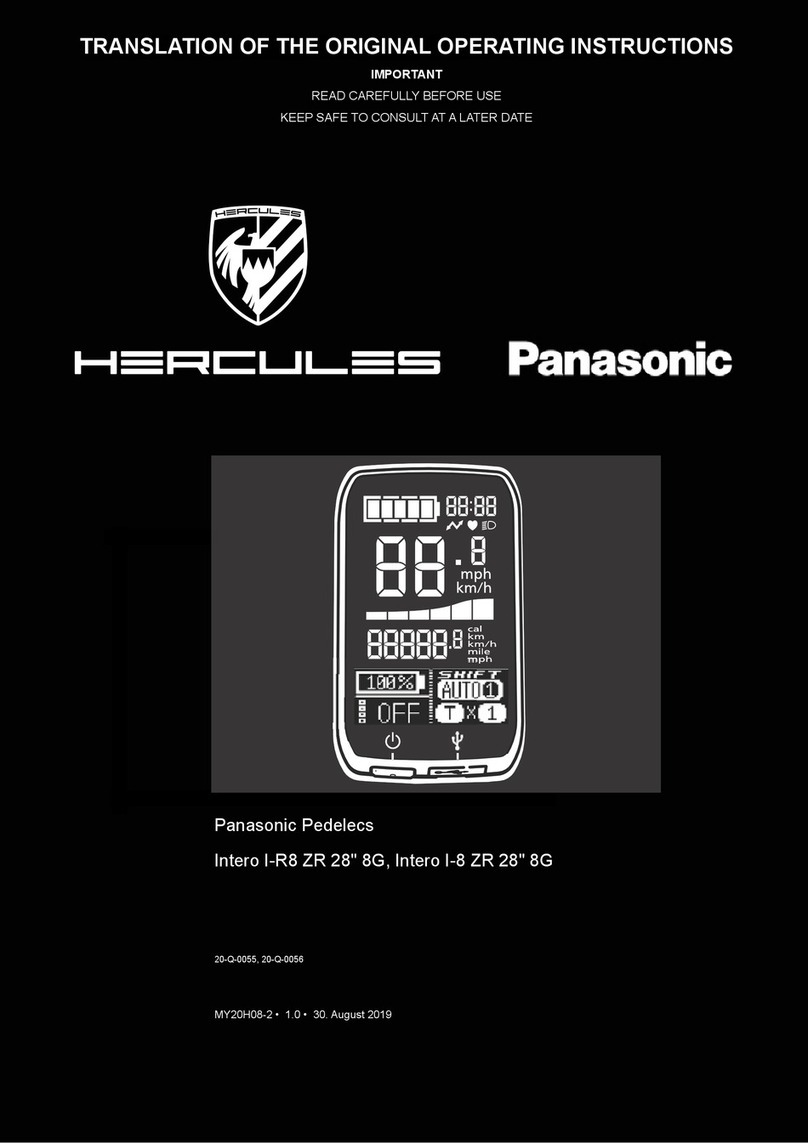
Hercules
Hercules Intero I-R8 ZR 28" 8G Series operating instructions

EARLY RIDER
EARLY RIDER T20 user manual
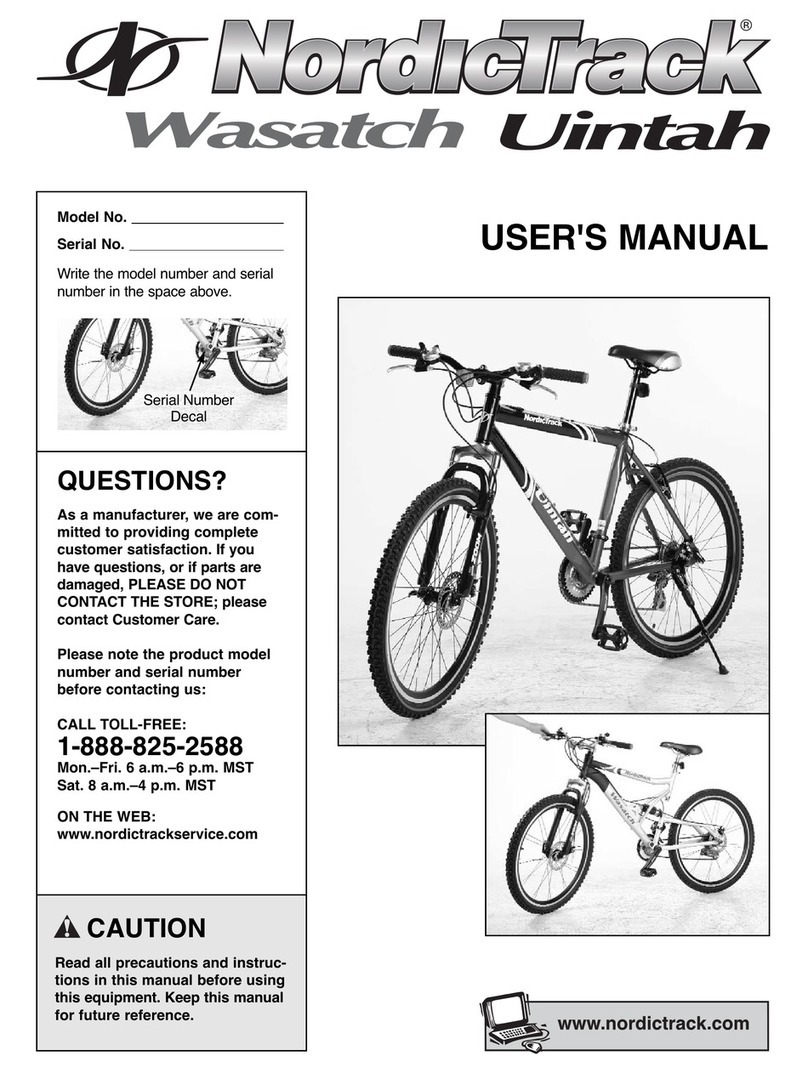
NordicTrack
NordicTrack Wasatch Uintah user manual
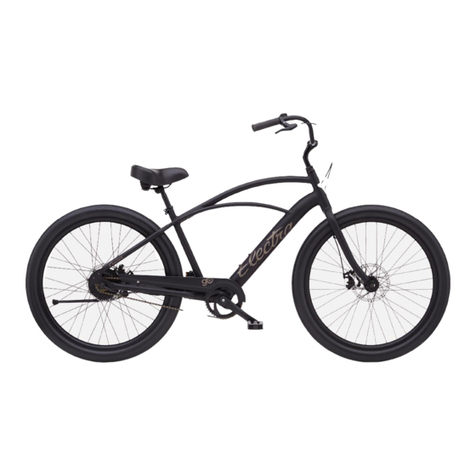
Electra
Electra HYENA quick start

Woom
Woom 1 Assembly instructions
